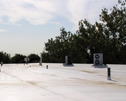In August 1994, the Occupational Safety and Health Administration (OSHA) issued new fall-protection regulations known as Subpart M. The regulations reduced the fall-protection trigger height from 16 to 6 feet, which affected all roofing contractors performing residential (steep-slope) work. It meant roofing work on virtually every structure required workers to use one of three conventional types of fall protection: guardrails, safety nets or personal fall-arrest systems.
The regulations allowed for using written site-specific fall-protection plans instead of conventional fall-protection methods if the employer could show such methods were infeasible or created a greater hazard. The burden with this option was proving infeasibility or greater hazard for every project, no matter how small or short-term.
Alternatives
In response to comments issued by NRCA explaining that conventional fall-protection options are not always the most effective for protecting workers in certain residential applications, OSHA considered adding an appendix to Subpart M—Appendix F: Residential Fall Protection Plan for Roofing Work.
Appendix F introduced eave slide guards' use on roofs with slopes between 4-in-12 (18 degrees) and 6-in-12 (27 degrees) where ground-to-eave heights are 25 feet or less. Additionally, for roofs with slopes of 6-in-12 (27 degrees) to 8-in-12 (34 degrees) with a similar height restriction, contractors could install additional slide guards going up the roof at intervals of 8 feet or less.
OSHA decided it would be better to drop Appendix F and develop separate guidelines; Interim Fall Protection Guidelines for Residential Construction was released in December 1995. The guidelines, which included Appendix F's key provisions, were intended to be a temporary solution until OSHA formally reopened Subpart M; more than 13 years have passed, and the guidelines still are in place.
NAHB concerns
NAHB asserts the directive has caused confusion among homebuilders and asked OSHA to remove the interim guidelines, as well as consider providing a definition of "residential construction" and allow employers to develop and use a standardized product-specific fall-protection plan. Additionally, NAHB asked OSHA's Advisory Committee on Construction Safety and Health (ACCSH) to formally request OSHA withdraw the directive.
NRCA has several problems with NAHB's requests. First, there is no evidence suggesting slide guards are not a viable fall-prevention alternative. Also, unscrupulous contractors often don't pay insurance premiums or taxes or care about job-site safety, so their prices are low. Professional roofing contractors can use slide guards as a low-cost, effective fall-prevention option and remain competitive, which offers customers a much better option for their roofing needs.
As an employer representative with ACCSH, I argued that removing the directive would put the roofing industry in the same position it was in 1994—without a viable, low-cost, easily installed alternative to conventional fall protection. Despite my objections, ACCSH is asking OSHA to withdraw the directive because a majority of ACCSH members believe conventional fall-protection options (guardrails, safety nets and personal fall-arrest systems) available today are easily installed and affordable.
Share your opinion
NRCA needs your feedback regarding this issue and would like to know about your experiences with fall-protection options, as well as your opinions. Please complete a brief survey and return it to NRCA so NRCA can approach OSHA with industry input. Otherwise, the roofing industry soon could lose an effective fall-prevention alternative.
Thomas R. Shanahan, CAE, is NRCA's associate executive director of NRCA University and risk management.



